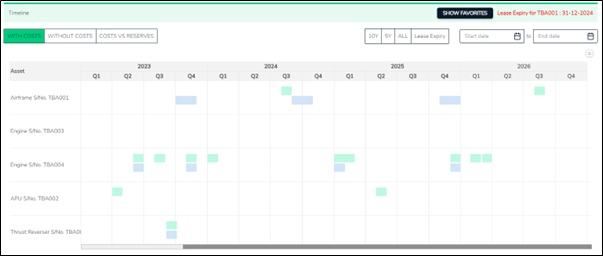
5 ways to make aircraft lifecycle asset management more efficient
The challenges of managing aviation assets are complex, from ensuring that parts meet airworthiness standards and lease return conditions, to planning for maintenance and key milestone events across an entire fleet.
In fact, time lost to inefficient processes can be one of the biggest challenges for airline asset or fleet management teams, resulting in redelivery delays or penalties, missed opportunities to maximise asset utilisation and therefore, a hit on your bottom line.
These five ways to streamline your asset management processes are designed to keep your fleet flying smoothly throughout the aircraft lifecycle. Let’s jump straight in!
1. Understand lease conditions and airworthiness standards
Meeting airworthiness requirements are top of mind for fleet and technical managers to keep each aircraft flying safely. However, it’s also important to keep lease conditions in mind as they often differ to regulations – for example, tighter thresholds for Life Limited component replacements. Therefore, it’s important to take both into consideration when maintaining your fleet to avoid nasty surprises as you get closer to transition.

That in itself isn’t always plain sailing though as lease contracts can be notoriously complex and difficult to interpret, particularly if you don’t have this niche expertise in-house. Bringing in a transition management expert to consult can be a helpful step in maximising your efficiency in this area, as you’ll be able to proceed with actions and forward planning, safe in the knowledge you’re compliant with both regulations and contracts.
Automating the interpretation of lease contracts can make aircraft lifecycle asset management more efficient, allowing your teams to spend their time planning ahead and actioning crucial items rather than combing through lengthy documentation. For example, software like flydocs Lifecycle Asset Management takes lease contracts and combines it with your live engineering data to clearly display which assets meet, or don’t meet, your contractual obligations in their current and predicted future state.
2. Leverage data and predictive analytics to plan ahead
Aircraft generate a wealth of data during operation and by harnessing it correctly, airlines and operators can translate this data into actionable insights.
With these insights, technical and fleet managers can effectively plan ahead for important milestones in the aircraft lifecycle, allowing you to schedule maintenance proactively, minimising downtime and maximising aircraft availability.
For example, aviation lifecycle asset management software like LAM visually displays your timeline of maintenance events, with scenario modelling (e.g. on lease extensions, or a change of route or region) that predicts the impact of each on the event timeline.
You’ll also be able to make data-backed decisions quickly, thanks to visual comparisons of different scenarios on maintenance event costs all within a single platform.

LAM Maintenance Events & Scenario Modelling
3. Invest in a robust technical records process
It’s not just components themselves that can cause a challenge. Each component can easily come with hundreds or even thousands of technical documents, all of which need to be collated during various stages of the aircraft lifecycle, including lessor inspections or redeliveries.
If you don’t have a thorough, standardised technical records management process in place, this can cause a real headache for airlines trying to find, check, correct and present documents to lessors or future onward buyers, taking up many days of team resource that could otherwise be used on other critical tasks.
Optimising this process could look like storing records digitally online rather than in paper form, auditing documents as they’re completed and uploaded to ensure errors are identified more efficiently or automating the process of key tasks, such as delivery binder creation.
Of course, we’d recommend opting for a digital solution that can do all the above and more, such as flydocs Digital Records Management (DRM) software. The platform connects with your M&E system and other software to help you gather a complete picture of your aircraft throughout its lifecycle. It can even automate the creation of a delivery binder, slashing the manual work required to build this hefty document by up to 90%.
4. Optimise maintenance reserve (MR) management
By using live financial and technical data, forecasting your aircraft’s future maintenance needs with greater accuracy is vital for any airline Finance teams. This helps you determine the appropriate amount of funds to allocate to your MR, avoiding the pitfall of either underfunding or overfunding.
Being able to manage this within a seamless visual interface allows you to easily identify areas for potential cost savings, allowing the redistribution of valuable funds for optimal efficiency.
On the other hand, you’re also able to see where forecast costs exceed reserves in advance, supporting effective budget planning and enabling you to avoid unexpected extra costs.

5. Leverage software to maximise component and Life Limited Part (LLP) utilisation
Keeping your aircraft operational means having the right components at the right time, but we understand this can cause challenges with information scattered across different systems and crucial details buried in hard-to-decipher formats. This is where specialised software comes to the rescue.
By implementing a strong lifecycle asset management system, you’re able to see the bigger picture from your component data and identify opportunities to maximise the lifespan and utilisation of each part. Imagine receiving recommendations on which aircraft could benefit from specific component swaps in order to extend its service life and save you the cost of a brand-new replacement.
Furthermore, Lifecycle Asset Management software can help you avoid the costly pitfall of paying AOG (Aircraft on Ground) prices for parts simply because they’re needed last minute to meet lease return conditions. With improved planning and better visibility into component availability, you can strategically manage your parts inventory. This allows you to retain valuable components within your fleet rather than returning them to lessors with minimal use, optimising both financial and internal resources.
How we can support more efficient airline lifecycle asset management
At flydocs, we’re powering smarter asset management with a combination of software and tech expertise. This means that over the years, we’ve learned a thing or two about how airlines can protect asset value by managing technical records and data more efficiently.
To explore how we can help you, reach out for a 30-minute no obligation chat.
